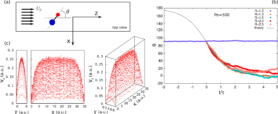
Giulia Fiorucci
Leonard S. Ornstein Laboratory, room 0.16
Princetonplein 1, 3584 CC Utrecht
P.O. Box 80 000, 3508 TA Utrecht
The Netherlands
phone: +31 (0)30 253 2467
secretariat: +31 (0)30 253 2952
e-mail: g.fiorucci@uu.nl
Research
Promotor: Prof. dr. ir. Marjolein Dijkstra
Funding: MCEC
Employed: 1 April 2015 – 30 March 2019
Hydrodynamics in colloidal systems
We perform numerical simulations of colloidal particles embedded into a fluid phase of solvent particles and we analyze the behavior and the properties of this system in several physical conditions. Our aim is to investigate the dynamics of colloidal suspensions in the presence of the solvent, which is responsible for the transport of momentum throughout the system. This naturally leads to the coupling of colloidal particles, resulting as an effective interaction -hydrodynamic interactions (HI) which has many-body character. The incorporation of the HI in our model, through the Stochastic Rotation Dynamics technique [1], enable us to characterize the role of hydrodynamics in colloidal systems. We study the system composed of a dumbbell particle dragged by the fluid flow in geometrical confinement; work inspired by the experiments on a microfluidic device [2]. This simple system already exhibits a large variety of behavior which is governed by the hydrodynamic interactions of the particle with itself and with the boundaries of the channel. In our study we focus on the self-interaction of the dumbbell, which is mainly responsible for the orientation of the particle along the direction of the fluid flow. For a symmetric particle we observe a lateral drift without any change in the orientation, however in an asymmetric particle the smaller sphere is dragged upstream, reaching the equilibrium position. At the moment we are performing several simulations at different Peclet numbers, exploring up to the region where the Brownian forces are of the same order of the hydrodynamic forces and verify up to which physical condition it is possible to have stable self-orientating phenomena.
Figure 1: a) Sketch of the system: a dumbbell particle in a channel with external flow. b) θ angle as a function of time. c) Velocity profile of solvent particles.
[1] J. T. Padding and A. A. Louis, Phys. Rev. E 74, 031402 (2006)
[2] E. Uspal et al., Nature Communications 4, (2013)

